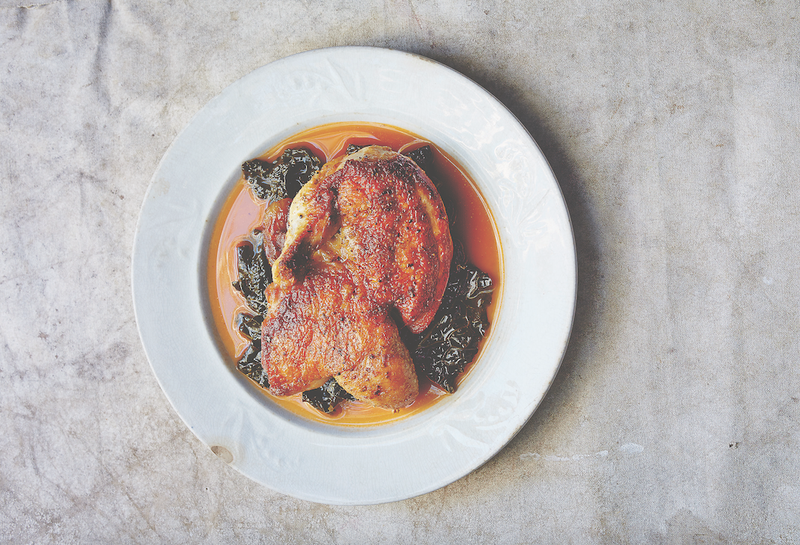I’m no fool. I’d watched Julia Child and Jacques Pepin debone a chicken enough times to know I wanted nothing to do with it. That is, until I landed on the roasted chicken recipe in Travis Lett’s cookbook, Gjelina, out today. The crispy, boneless bird placed atop a burial mound of kale is a customer favorite at Lett’s Los Angeles-based restaurant of the same name and looked too good to pass up. Debone, I would.

I dutifully followed Travis Lett’s deboning instructions—a lax term for his one, largely unhelpful tip—to “find a good tutorial online,” which is how I found myself this past Friday evening scouring YouTube for its best ossein-ousting tips.
The video I landed on (vetted by its thousands of views) instructed me to first shake the bird from side to side to relax the muscle and joints, which I dutifully did, my chicken looking rather like a young Kevin Bacon introducing the good people of Bomont to the joys of prom. I soldiered on through the video, dancing chicken and all (this must be how all the sunny folks in SoCal work up that dewy glow.) I made it as far as removing the wing and leg bones, and making incisions along either side of the breast bone before calling for help.


Left: The saddest (almost) deboned chicken there ever was. Right: Not quite what the cookbook looked like… but delicious nonetheless.
With one hand groping the chicken, I used my other to type an S.O.S. to the editorial team’s chat room, answered by Kristen Miglore. She wrote back, “Just pull away the meat with your left hand and use a pairing knife to nick away at the meat closest to the bone (Hi, everyone).”
I hacked away at the bird, not completely sure of what role deboning had in this entire process, but reserved my suspicions for the 8-minute roast time on Lett’s Roasted Cauliflower with Garlic, Parsley, and Vinegar. Maybe my issue came from the fact that my very-much-not-organic, supermarket bird, unlike Lett’s recommendation, had certainly never spent any time “walking around its yard, pecking at bugs and worms and snacking on leftover farm bits.”
At last, I released my Franken-chicken from it’s skeletal cage, set it in a pan, and turned my attention to the Garlic Confit that had been quietly roasting throughout the entire poultry fiasco.


Before (left) and after (right)
I learned early on in the Gjelina cooking process that with every recipe comes another recipe altogether. The roasted chicken calls for Tomato Confit, the roasted artichokes for Crispy Shallots, and the roasted cauliflower requests three cloves of Garlic Confit. But I can’t say I wasn’t warned. As with most cookbooks born out of restaurants, there’s a whole section in the book of Condiments and Pickles, condiments and pickles mixed and matched throughout the book to create new dishes. Lett writes, “We use the condiments in this chapter in a variety of ways, much like an artist building a collage.”
To the editor who decided to make full-blown, last-minute Venice-ian feast, the 45 minutes it takes to roast Garlic Confit before even starting on the cauliflower itself was an unwelcome addition. To the cook who is able to plan their menu (or at least, read recipes and prepare ahead), the condiments section offers a wealth of make-ahead possibilities. Even after adding three cloves to a cast iron pan of seared cauliflower a full hour behind schedule, I was able to see that the condiments are the heart of the book—and the part that makes all the “deboned chicken” YouTube videos forgiveable.


Left: Roasted Cauliflower with Garlic, Parsley, and Vinegar; Right: Butterscotch Pots de Crème with Salted Caramel.
The chapter is a description of exactly what I wish my pantry looked like—filled with jars of pesto, herb emulsions, and pickled eggplants, onions, and chiles. I followed these recipes to a T while envisioning how I might adapt the vegetable and meat dishes, which don’t involve any new or ground-breaking techniques—Lett prides himself on applying “only minimal amount of process” to foods—but are filled with big ideas.
Every recipe calls to mind a Californian ideal—a world where mornings start off with walks along the beach to the Santa Monica farmers market, kale is a state of mind, and pasture-raised chicken meat falls right off the bone. And somewhere between the perfectly roasted cauliflower and pickled eggplant (eaten over the sink while the chicken cooked) and the last bite of the just-salty-enough Butterscotch Pots de Crème, I began to believe in it all. But I’ll save my deboning for trout.
Gjelina’s Butterscotch Pots de Crème with Salted Caramel
Serves 8
For the pots de crème:
9 egg yolks, at room temperature
1 1/4 cups packed dark brown sugar
4 tablespoons unsalted butter
3 1/2 cups heavy cream
1 teaspoon kosher salt
1/2 vanilla bean, split lengthwise
1/4 cup granulated sugar
2 1/4 teaspoons water
1/4 teaspoon kosher salt
1/3 cup heavy cream
1/4 cup whipping cream
1 tablespoon Buttermilk Crème Fraîche
Flaky sea salt for sprinkling
For the Buttermilk Crème Fraîche:
4 cups heavy cream
1 tablespoon buttermilk
See the full recipe (and save and print it!) here.
Have you ever been to Gjelina? Is there a dish you can’t wait to cook? Tell us in the comments below!
Photos by Michael Graydon and Nikole Herriott
(via Food52)
